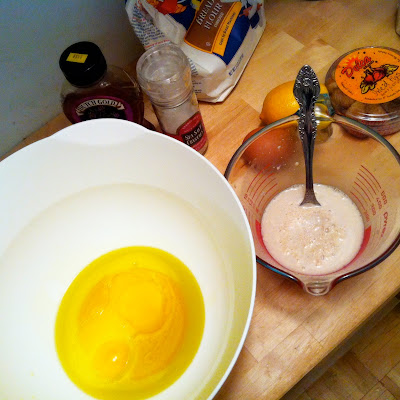Cream soup with sweet red pepper
After spending so many of my vacations (basically all of them the past several years) with my friend and almost sister Catherine, I have picked up not a little of her cooking. This simple yet filling and delicious soup is one she often made for dinner and it was easy to see why - not only is it not too heavy to eat in the evening; it is also very easy to make and for someone always working or studying and the mother of two kids, a quick nutritious meal is a godsend.
I've changed very little from her soup, except for the substitution of crème fraîche for whatever local variant I have - smetana in Russia and sour cream in the U.S. - speaking of which, not long ago I wrote a whole newspaper column about this dairy product. I've also sprinkled some cheese on top instead of an extra dollop of sour cream - but that is optional.
Here is (some of, since I forgot a few) the cast of characters:
2 extra large sweet red peppers - or 3 large ones
2 medium onions
4 cloves of garlic
1 medium large potato (or in my case, several extremely small ones)
1 cup sour cream (more if you want to top your soup with it) - choose whatever fat content you wish!
1 cube vegetable bouillon (try to find vegetable or mushroom bouillon - the flavor of chicken or beef gives the soup a not only boring but unappetizing generic saltiness)
2 tablespoons olive oil (not shown because I am forgetful)
some shaved Parmigiano-Reggiano cheese for topping - optional (not shown)
salt and pepper to taste (also not shown)

Optional: half a packet of Boursin cheese with garlic and fine herbs for an especially rich velvety soup.
Add the roughly chopped potato(es) and roughly chopped peppers and stir well. After a minute or so, put on the lid and continue cooking over medium heat - there should be enough moisture from the vegetables to keep them from burning or sticking to the pot (if not, lower the heat).
You want everything to sweat nicely - stir once every two three minutes, but otherwise keep the lid on and cook until the peppers start to wilt.
Add a cup of water and the cube of vegetable stock and cook for ten more minutes, or until the potatoes are cooked.
Lower the heat and add the sour cream or crème fraîche (or smetana). If using Boursin cheese, add it now. Stick an immersion blender in the pot and puree until smooth.
If you are using crème fraîche, it will not curdle, but if you are using anything else, it is best to keep things at a very low simmer after this point. Add salt and pepper to taste - I usually add at least half a teaspoon of salt, but it depends on how salty your bouillon cube is. Also, if you add Boursin cheese, that is very salty, so add salt only at the very end.
Top with the shaved Parmigiano-Reggiano and sprinkle with freshly ground pepper.
This recipe serves two for a filling meal, or three if no one takes seconds! But better make more than less, because it is delicious and you will want seconds for sure. Serve with a crusty baguette and some cheese and a light green salad.
You can also replace the red peppers in this soup with some other kind of vegetables - I've tried it with zucchini, pumpkin, green peppers, broccoli, or a mixture of several vegetables. You can also replace the onions with the white parts of leek, or use both the white and green parts for a leek soup. It will doubtlessly be a very fancy and beautiful soup made with asparagus. If using red pepper or pumpkin, you can also add some sun-dried tomatoes for a deeper flavor.






















































